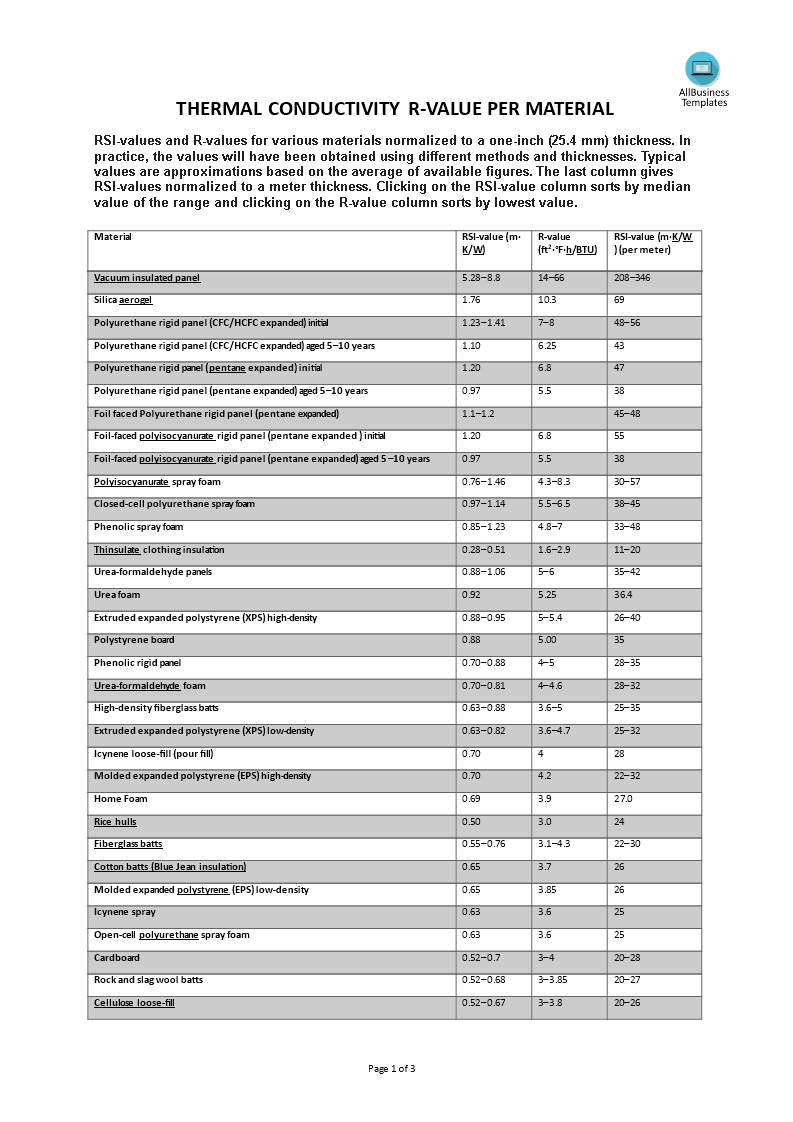Heat Transfer Coefficient R Value Types and Conversions

Opslaan, invullen, afdrukken, klaar!
How to calculate the Thermal Conductivity R-Value of material? And how to do conversions between R-Value in USA and RSI value? Download this Heat Coefficient R-
Beschikbare bestandsformaten:
.docx- Gevalideerd door een professional
- 100% aanpasbaar
- Taal: English
- Digitale download (35.4 kB)
- Na betaling ontvangt u direct de download link
- We raden aan dit bestand op uw computer te downloaden.
Zakelijk gebouw Bouwtechnologie Technisch Warmte Isolatie
How to calculate the Thermal Conductivity R-Value of material? And how to do conversions between R-Value in USA and RSI value? Download this Heat Coefficient R-Value for all material types and conversions template that will perfectly suit your needs!
Engineers, Architects and scientists regularly need advanced templates, forms, spreadsheets to perform their calculations. For example, this Heat Coefficient R Value Types and Conversions template which can save you valuable time and can help you with your research and your calculations.
The R-Value is an imperial system unit of measurement (ft2·°F·h/BTU) and the RSI Value is a metric system unit of measurement (m2·K/W). The higher the resistance value, the slower the rate of heat transfer through the insulating material.
- Convert an RSI Value to an R-Value, multiply the RSI Value by 5.678.
- Convert an R-Value to an RSI Value, divide the R-Value by 5.678.
Try it now and let this engineering template inspire you. We certainly encourage you to use this Heat Coefficient R-Value Types and Conversions for your own activities and are confident it will fit your needs.
RSI-values and R-values for various materials normalized to a one-inch (25.4 mm) thickness. In practice, the values will have been obtained using different methods and thicknesses. Typical values are approximations based on the average of available figures. The last column gives RSI-values normalized to a meter thickness. Clicking on the RSI-value column sorts by the median value of the range and clicking on the R-value column sorts by lowest value. This Sheet contains R-values for the following building materials:
- Vacuum insulated panel
- Silica aerogel
- Polyurethane rigid panel (CFC/HCFC expanded) initial
- Polyurethane rigid panel (CFC/HCFC expanded) aged 5–10 years
- Polyurethane rigid panel (pentane expanded) initial
- Polyurethane rigid panel (pentane expanded) aged 5–10 years
- Foil-faced Polyurethane rigid panel (pentane expanded)
- Foil-faced polyisocyanurate rigid panel (pentane expanded ) initial
- Foil-faced polyisocyanurate rigid panel (pentane expanded) aged 5–10 years
- Polyisocyanurate spray foam
- Closed-cell polyurethane spray foam
- Phenolic spray foam
- Thinsulate clothing insulation
- Urea-formaldehyde panels
- Urea foam
- Extruded expanded polystyrene (XPS) high-density
- Polystyrene board
- Phenolic rigid panel
- Urea-formaldehyde foam
- High-density fiberglass batts
- Extruded expanded polystyrene (XPS) low-density
- Icynene loose-fill (pour fill)
- Molded expanded polystyrene (EPS) high-density
- Home Foam
- Rice hulls
- Fiberglass batts
- Cotton batts (Blue Jean insulation)
- Molded expanded polystyrene (EPS) low-density
- Icynene spray
- Open-cell polyurethane spray foam
- Cardboard
- Rock and slag wool batts
- Cellulose loose-fill
- Cellulose wet-spray
- Rock and slag wool loose-fill
- Fiberglass loose-fill
- Polyethylene foam
- Cementitious foam
- Perlite loose-fill
- Wood panels, such as sheathing
- Fiberglass rigid panel
- Vermiculite loose-fill
- Vermiculite
- Strawbale
- Papercrete
- Softwood (most)
- Wood chips and other loose-fill wood products
- Aerated/Cellular Concrete (5% moisture)
- Snow
- Hardwood (most)
- Brick
- Glass
- Poured concrete
- Etc.
Download this ready-to-use Heat Coefficient R-Value Types and Conversions template now!
DISCLAIMER
Hoewel all content met de grootste zorg is gecreërd, kan niets op deze pagina direct worden aangenomen als juridisch advies, noch is er een advocaat-client relatie van toepassing.
Laat een antwoord achter. Als u nog vragen of opmerkingen hebt, kunt u deze hieronder plaatsen.

